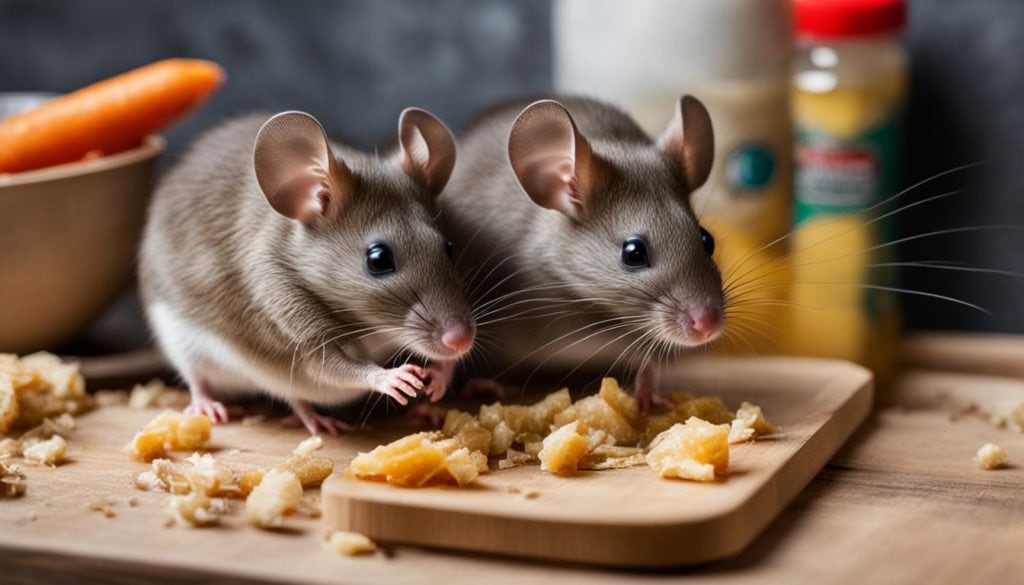Do you have mice in your home or office? It’s important to understand the health risks associated with these pesky rodents. Not only can they cause damage to your property, but they can also pose a threat to your well-being. In this article, we will explore the dangers of mice and the potential health risks they bring.
Key Takeaways:
- House mice can breed rapidly and cause infestations in homes and offices.
- Mice can damage appliances, furniture, and even start electrical fires.
- They can carry disease-causing bacteria, such as salmonella, and contaminate food sources.
- While not commonly known to transmit rabies, mice can spread dozens of other diseases to humans through contact or indirectly through mites or fleas.
- Identifying a mouse infestation is crucial in taking appropriate actions to address the problem.
Identifying a Mouse Infestation
If you suspect that there may be mice in your home or office, it’s important to be able to identify the signs of a mouse infestation. By recognizing these indicators, you can take appropriate action to address the issue before it becomes a larger problem.
Signs of a Mouse Infestation
There are several common signs that may indicate the presence of mice in your environment:
- Mouse droppings: Look for small, rod-shaped droppings, typically about the size of a grain of rice.
- Gnaw marks: Check for gnaw marks on household items or food containers. Mice have a strong need to chew to keep their teeth from growing too long.
- Footprints: Look for footprints with 4-toed prints made by their front feet and 5-toed prints made by their hind feet.
- Oily rub marks: Keep an eye out for oily rub marks along walls. Mice often leave these marks as they navigate through narrow spaces.
- Foul odor: Take note of any distinct smell of mouse urine. This odor may be particularly noticeable in enclosed spaces.
- Runways: Look for runways lined with rub marks, droppings, and footprints. These are commonly found along walls or baseboards.
- Burrows: Check for burrows containing nesting materials, such as shredded paper or fabric. Mice use these burrows for shelter and reproduction.
It’s also important to pay attention to any actual sightings of mice or any items that have been damaged. These are clear signs that a mouse infestation is present.
| Signs of a Mouse Infestation | What to Look For |
|---|---|
| Mouse droppings | Rod-shaped droppings about the size of a grain of rice |
| Gnaw marks | Damaged household items or food containers |
| Footprints | 4-toed prints with front feet, 5-toed prints with hind feet |
| Oily rub marks | Rub marks along walls or baseboards |
| Foul odor | Distinct smell of mouse urine |
| Runways | Paths with rub marks, droppings, and footprints |
| Burrows | Underground tunnels with nesting materials |
By keeping an eye out for these signs, you can quickly determine if you have a mouse infestation and take appropriate steps to address the problem. Remember, early detection is key to preventing further damage and potential health risks.
Now that you know how to identify a mouse infestation, it’s time to learn about the health risks associated with these unwanted pests. In the next section, we’ll explore the diseases that can be spread by mice and the potential dangers they pose to you and your loved ones.
Health Risks of Mouse Infestations

Mice infestations pose significant health risks due to the diseases they can carry and spread. It is crucial to be aware of these risks and take appropriate measures to protect yourself and your surroundings. Here are some of the diseases associated with mouse infestations:
Hantavirus
Hantavirus is a potentially life-threatening respiratory disease transmitted through contact with infected rodent urine, droppings, or saliva. It can be contracted by inhaling dust particles contaminated with the virus. Hantavirus infections can cause severe symptoms such as fever, muscle aches, fatigue, and shortness of breath. In some cases, it can lead to Hantavirus Pulmonary Syndrome (HPS), which can be fatal.
Salmonellosis
Salmonellosis is a type of food poisoning caused by consuming food or water contaminated with the bacteria present in rodent feces. Mice can easily contaminate food sources, utensils, and surfaces, increasing the risk of salmonellosis. Symptoms include diarrhea, fever, abdominal cramps, and vomiting, which typically appear within 12 to 72 hours after infection.
Rat-Bite Fever
Rat-bite fever is a bacterial infection that can be transmitted through bites or scratches from infected rats. It can also be contracted by handling rodents or consuming food or water contaminated with their saliva. Symptoms of rat-bite fever may include fever, chills, headache, muscle pain, joint pain, and rash. If left untreated, it can lead to more severe complications.
It is important to prioritize the prevention, identification, and elimination of mouse infestations to minimize these health risks. By maintaining cleanliness, sealing potential entry points, and seeking professional help, you can effectively protect yourself and your environment from the dangers associated with mouse infestations.
| Disease | Transmission | Symptoms |
|---|---|---|
| Hantavirus | Contact with infected rodent urine, droppings, or saliva | Fever, muscle aches, fatigue, shortness of breath |
| Salmonellosis | Ingesting food or water contaminated with rodent feces | Diarrhea, fever, abdominal cramps, vomiting |
| Rat-Bite Fever | Bites, scratches, or handling infected rats | Fever, chills, headache, muscle pain, joint pain, rash |
Diseases Spread by Rats
Rats, like mice, can also carry and spread diseases that pose health risks to humans. One of the most well-known diseases associated with rats is the bubonic plague. The bubonic plague is caused by the bacterium Yersinia pestis, which is typically transmitted to humans through infected fleas that live on rats. The disease is characterized by symptoms such as fever, headaches, and swollen lymph nodes. While the bubonic plague is relatively rare in modern times, it is still a serious illness that requires prompt medical attention.
In addition to the bubonic plague, rats can also spread other diseases such as rat-bite fever. Rat-bite fever is caused by bacteria carried by rats and can be transmitted through bites or scratches. Symptoms of rat-bite fever include fever, vomiting, muscle pain, and rash. Like the bubonic plague, rat-bite fever requires medical treatment to prevent complications and ensure recovery.
To effectively prevent the spread of diseases from rats, it is crucial to eliminate rat infestations and take preventive measures. This includes maintaining proper sanitation practices, such as securely storing food in rodent-proof containers, keeping garbage areas clean and sealed, and sealing any potential entry points into buildings. Regular pest control inspections and treatments can also help in preventing and controlling rat infestations.
| Disease | Symptoms | Treatment |
|---|---|---|
| Bubonic Plague | Fever, headaches, swollen lymph nodes | Antibiotics |
| Rat-Bite Fever | Fever, vomiting, muscle pain, rash | Antibiotics |
It is important to take rat infestations seriously and address them promptly to protect yourself and your family from the health risks associated with these diseases. If you suspect a rat infestation, it is recommended to seek professional assistance from pest control experts who have the knowledge and expertise to safely and effectively eliminate rats from your property.
How to Safely Clean Up Rodent Droppings

When it comes to cleaning up rodent droppings, it’s important to take the necessary precautions to protect yourself from potential health risks. Rodents, including mice, can carry diseases that can be transmitted through their droppings, such as hantavirus, lymphocytic choriomeningitis, and rat-bite fever. Here are some steps you can follow to safely clean up rodent droppings:
Gather the Right Tools and Protective Gear
Before you begin cleaning, make sure you have the right tools and protective gear. This includes disposable gloves, a face mask, and safety goggles. These items will help minimize the risk of exposure to airborne pathogens and prevent direct contact with the droppings.
Contain and Remove the Droppings
First, dampen the droppings with a disinfectant or a mixture of bleach and water. This will help prevent dust particles from becoming airborne. Then, use paper towels or disposable cloths to carefully pick up the droppings, taking care not to crush or scatter them. Place the droppings in a sealed plastic bag.
Clean and Disinfect the Area
After removing the droppings, thoroughly clean and disinfect the area using a household disinfectant or a bleach solution. Pay close attention to surfaces that may have come into contact with the droppings, such as countertops, floors, and walls. Dispose of cleaning materials and gloves in a sealed plastic bag.
Properly Dispose of Waste
Double bag the sealed plastic bag containing the droppings and any used cleaning materials. Make sure the bags are securely tied. Place the bags in an outdoor garbage bin, away from any entrances to your home. Wash your hands thoroughly with soap and water after handling the waste.
| Important Tips for Safe Cleanup |
|---|
| Always avoid sweeping or vacuuming rodent droppings, as this can aerosolize the pathogens and increase the risk of inhalation. |
| Never use your bare hands to handle rodent droppings, as this can lead to direct contact with disease-causing pathogens. |
| If you’re unsure about how to safely clean up rodent droppings or if you’re dealing with a large infestation, it’s best to contact a professional cleaning service for assistance. |
By following these steps and taking the necessary precautions, you can safely clean up rodent droppings and reduce the risk of exposure to diseases. Remember to always prioritize your safety when dealing with rodent infestations and seek professional help when needed.
Prevention and Control of Rodent Infestations

To keep your home and surroundings free from rodent infestations, it’s essential to take proactive measures and implement effective prevention strategies. By following these rodent prevention tips, you can minimize the risk of an infestation and protect your property.
Seal Entry Points
One of the most critical steps in rodent-proofing your home is to seal any potential entry points that mice and rats can exploit. Inspect your house for cracks, gaps, and holes, and use materials such as steel wool, caulk, or wire mesh to seal them. Pay close attention to areas around windows, doors, utility openings, vents, and pipes. By blocking off these access points, you can significantly reduce the chances of rodents finding their way into your living spaces.
Maintain Cleanliness and Good Sanitation
Keeping your living environment clean and free from potential food sources is another effective way to prevent rodent infestations. Store food in tightly sealed containers, including pet food, and avoid leaving crumbs or spills that can attract mice and rats. Regularly clean up any food debris, sweep the floors, and take out the garbage regularly. By depriving rodents of easily accessible food, you can discourage them from setting up camp in your home.
Remove Outdoor Attractions
Rodents are often drawn to outdoor areas that provide shelter and easy access to food. Trim tree branches that hang over your house and keep shrubs and vegetation near buildings well-maintained to eliminate potential hiding spots. Additionally, secure garbage bins with tight-fitting lids and routinely clean up fallen fruits or bird feeders that can attract rodents. By minimizing these outdoor attractions, you can reduce the likelihood of rodents establishing a presence near your home.
By implementing these rodent prevention tips and maintaining good hygiene practices, you can create an environment that is unappealing to mice and rats. While these measures can help minimize the risk of infestations, it’s always a good idea to consult with a professional pest control service if you suspect or encounter rodent activity in your home. Remember, prevention is key to safeguarding your property and ensuring a rodent-free living space.
Conclusion
In conclusion, it’s important to understand the health risks associated with mice infestations in order to protect yourself and your home. Mice can carry disease-causing bacteria like salmonella and spread it to your food sources, putting your health at risk. They can also transmit other diseases, such as hantavirus and rat-bite fever, which can have severe consequences if not treated promptly.
To protect against rodent infestations, there are several steps you can take. Keep your home clean and clutter-free, as mice are attracted to food and nesting materials. Seal cracks and holes in your home’s exterior to prevent them from entering. Store your food in airtight containers to minimize the risk of contamination. Regularly dispose of garbage and maintain proper ventilation in your attic and basement.
If you suspect a mouse infestation, it’s best to seek professional help. Cleaning up rodent droppings should be done with caution to avoid spreading airborne pathogens. Consider hiring a professional cleaning service that specializes in handling these situations to minimize the risk of exposure. It’s crucial to take proactive measures to prevent and address mouse infestations to maintain a safe and sanitary living environment.
FAQ
What are the signs of a mouse infestation?
Signs of a mouse infestation include finding rod-shaped droppings, gnaw marks on household items or food containers, footprints with 4-toed prints with their front feet and 5-toed prints with their hind feet, oily rub marks along walls, a distinct smell of mouse urine, runways lined with rub marks, droppings, and footprints, and burrows containing nesting materials. Actual sightings of mice and damaged items can also indicate an infestation.
What diseases can mice spread?
Mice can spread diseases such as hantavirus, salmonellosis (a type of food poisoning spread by rodent feces), and rat-bite fever. These diseases can cause symptoms such as fatigue, fever, nausea, and headaches, and in severe cases, they can lead to respiratory failure or permanent damage to the nervous system.
What diseases can rats spread?
Rats can spread diseases such as the bubonic plague (transmitted by infected rodent fleas) and rat-bite fever (caused by bacteria carried by rats). Symptoms of these diseases include fever, headaches, and swollen lymph nodes. Prompt treatment is necessary to avoid serious health consequences.
How should I clean up rodent droppings?
Cleaning up rodent droppings should be done with caution to avoid spreading airborne pathogens. It is recommended to hire a professional cleaning service that specializes in handling these situations to minimize the risk of exposure. Protective gear should be worn, and droppings should be removed promptly to reduce the chances of contamination. Rodent droppings can spread diseases such as hantavirus, lymphocytic choriomeningitis, and rat-bite fever.
How can I prevent and control rodent infestations?
To prevent and control rodent infestations, homeowners should take measures such as installing door sweeps on exterior doors, repairing damaged screens, sealing cracks and holes on the outside of the house, keeping food in airtight containers, disposing of garbage regularly, and keeping attics and basements well-ventilated. Regular pest control and thorough inspections can help identify and eliminate potential entry points for rodents.
Source Links
- https://www.webmd.com/a-to-z-guides/know-about-house-mice
- https://www.spauldingdecon.com/blog/diseases-from-mice-to-humans
- https://www.pestworld.org/news-hub/pest-health-hub/overview-of-the-real-health-risks-posed-by-mice-and-rat-infestations/

Welcome to micegoneguide.com, your go-to resource for eliminating rats and mice. Say goodbye to rodent infestations with our expert tips and strategies. Visit us now and reclaim your space!

